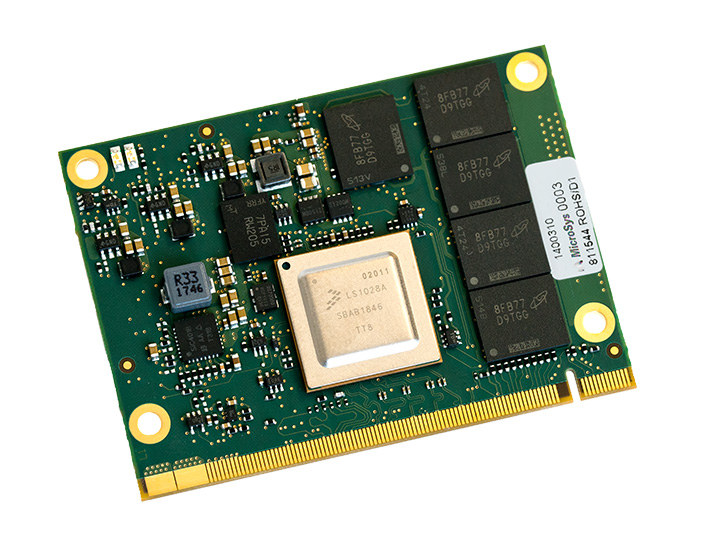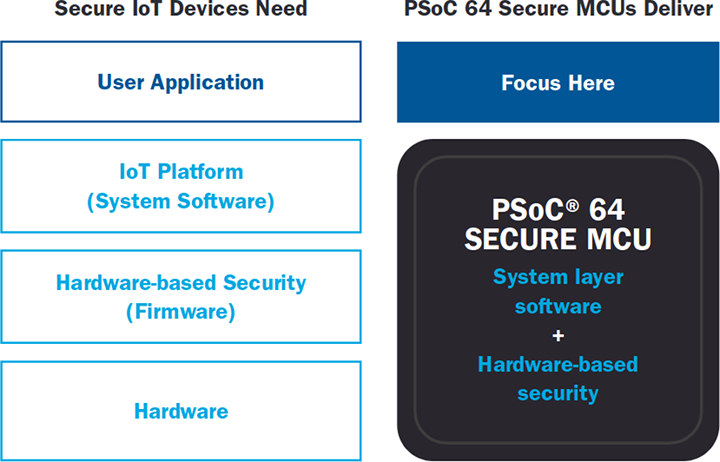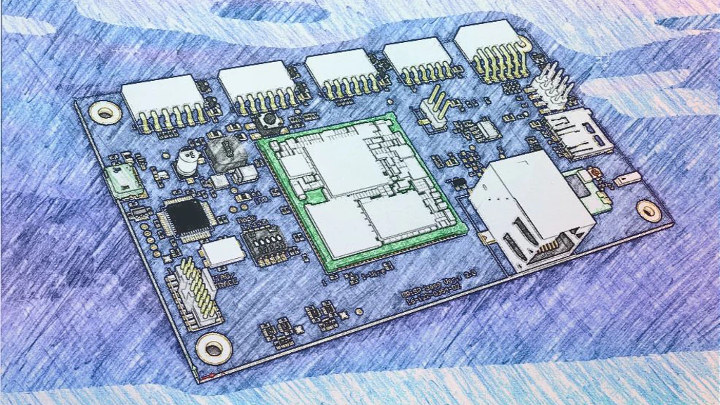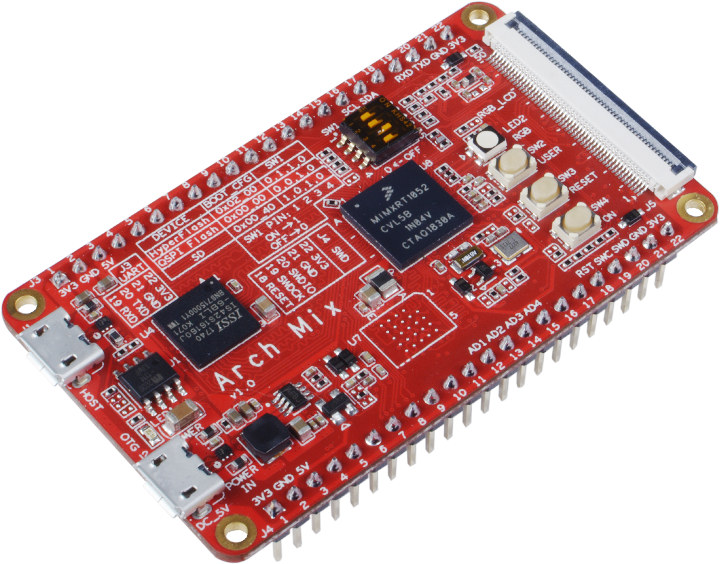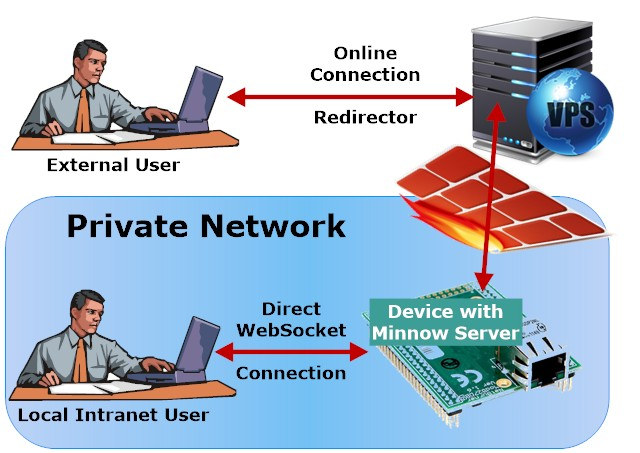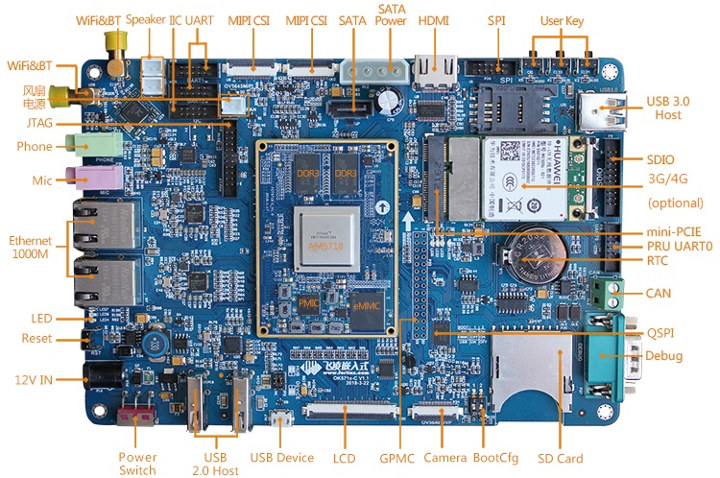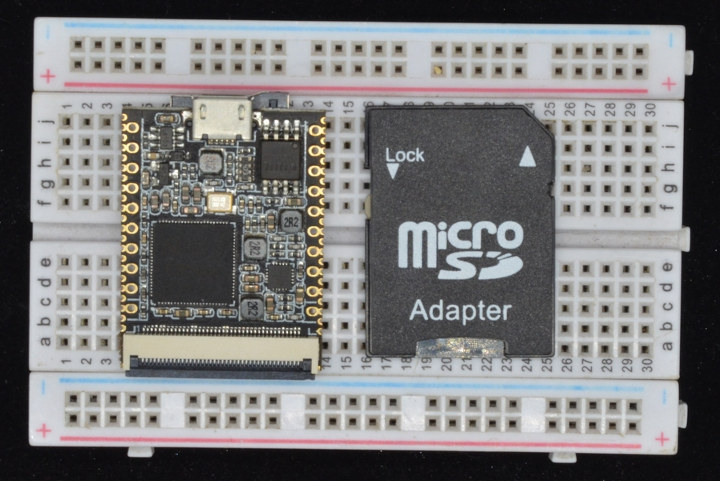A few years ago, we came across GigaDevice GD32 microcontroller compatible with STMicro STM32F103, but with a higher 108 MHz clock, and zero wait state internal flash. The MCU was also a drop-in replacement for the STMicro alternative since beside being software compatible, it was also pin-to-pin compatible. The company is now back with a new microcontroller, but it’s not Arm-based. Instead, GigaDevice GD32V is based on RISC-V open source architecture. GD32V General Purpose RISC-V MCU GigaDevice GD32V is a 32-bit RISC-V general-purpose MCU that targets industrial and consumer applications such as IoT, edge computing, artificial intelligence and “vertical industries”. The new GD32VF103 series RISC-V MCU family features 14 models with the following key specifications: Core – GD32VF103 32-bit rv32imac RISC-V “Bumblebee Core” @ 108 MHz Memory – 8KB to 32KB SRAM Storage – 16KB to 128KB flash Peripherals – USB OTG and CAN 2.0B I/O – 3.3V, 5V tolerant […]
miriac MPX-LS1028A NXP QorIQ LS1028A SoM Targets TSN Applications with HMI Display
NXP QorIQ LayerScape LS1028A communication SoC was first unveiled in March 2017 with two Armv8 cores, GPU and LCD controller for HMI systems, as well as Time-Sensitive Networking (TSN) capabilities useful in industrial settings. As usual it takes a while before the company finalize their design and software support, but LS1028A has started to appear at least in one hardware platform that’s supposed to launch this quarter (Q2 2019): MicroSys miriac MPX-LS1028A system-on-module. miriac MPX-LS1028A SoM specifications: SoC – NXP QorIQ LS1018 / LS1028 single / dual core Arm Cortex-A72 clocked at up to 1.3 GHz with MXC Vivante GPU, Mali Display Processor, configurable cryptographic offload engines (Optional: LS1017/LS1027 without GPU for cost saving) System Memory – Up to 4GB 32 Bit DDR4 with ECC RAM at up to 1600 MT/s Storage – Up to 256MB Serial NOR Flash & up to 4GB Serial NAND Flash; EEPROM MXM 2.0 edge […]
Cypress PSoC 64 Microcontrollers Target Secure IoT Applications
If you are like me, you probably don’t remember, but back in 2017 Arm announced the Platform Security Architecture (PSA) that defines a set of requirements to secure low cost Internet of Things devices. There’s now at least one PSA compliant microcontroller, as Cypress Semiconductor introduced their PSoC 64 Secure MCU at Embedded World 2019 last month. The press release claims that PSoC 64 MCU family is one of “the first Arm Cortex-M processors to be certified as Level 1 compliant within the Arm Platform Security Architecture (PSA) certification scheme, PSA Certified, utilizing a secure Trusted Firmware-M (TF-M) implementation integrated into the Arm Mbed OS open-source embedded operating system”. PSoC 64 secure MCU key features and specifications: Arm Cortex-M4F core with 22‑µA/MHz active power consumption Optional Arm Cortex-M0+ core with 15‑µA/MHz power consumption System Memory – 160KB to 1MB SRAM Storage – 512KB to 2MB flash Security HW Cryptography – […]
GRiSP 2 Board Targets Embedded Erlang & Elixir Development (Crowdfunding)
Erlang is described as a programming language used to build massively scalable soft real-time systems with requirements on high availability, and used in telecoms, banking, e-commerce, computer telephony and instant messaging. Elixir is a dynamic, functional language designed for building scalable and maintainable applications that leverages the Erlang VM, known for running low-latency, distributed and fault-tolerant systems. Elixir is used in many types of applications from higher-level web development to the embedded software domain, and Peer Stritzinger designed GRiSP board especially for the latter in 2017. He’s now back with GRiSP 2 featuring an NXP i.MX 6ULL SoM running Linux and RTEMS (Real-Time Executive for Multiprocessor Systems) RTOS. GRiSP 2 board is comprised of a system-on-module and baseboard with the following specifications: System on Module SoC – NXP iMX6UL Arm Cortex-A7 @ 696 MHz, 128 KB L2 cache, with TRNG, Crypto Engine (AES/TDES/SHA), Secure Boot Memory – 128 MB DDR3 […]
$30 Arch Mix Development Board Features NXP i.MX RT1052 Crossover Processor
NXP i.MX RT Arm Cortex-M7 crossover processors are supposed to fill the gap between microcontrollers and more powerful application processors thanks to real-time capabilities, and a higher CPU frequency. We’ve already covered several i.MX RT1050 series platforms including NXP’s own evaluation board and Forlinx OK1052-C development kit comprised of a carrier board and an i.MX RT1052 system-on-module. But if you’d like to experiment with NXP i.MX RT processor using a cheaper, smaller, and easier to purchase development platform, Seeed Studio has started to sell Arch Mix development board for $29.90 plus shipping. Arch Mix board specifications: SoC – NXP i.MX RT1052 Arm Cortex-M7 processor @ up to 528MHz System Memory – 32MB SDRAM Storage – Optional 64MB Hyperflash, 8MB QSPI flash, microSD card socket Display I/F – RGB LCD interface USB – 1x micro USB 2.0 host port, 1x USB OTG port for data and power Expansion Headers – 2x […]
Minnow Server is a Secure Web Server for Microcontrollers
Many embedded systems have a limited amount of memory, which would normally run programs with smaller footprints than on desktops or servers. For example, nginx and Apache2 are the common web servers, but on hardware with limited memory, smaller footprint web servers may be required, so that’s why I wrote a list of web servers for embedded systems running Linux/uClinux many years ago. But now, even platforms based on microcontrollers often need to run web server usually for configuration. We’ve already shown how to use Arduino to serve a simple web page and did the same in Getting Started with NodeMCU Board Powered by ESP8266 WiSoC but using Lua programming language instead. It may be more convenient to run a proper web server however, as it’s easier to change the interface, and we previously covered MicroWebSrv lightweight web server that works on platforms running MicroPython such as Pycom boards. Real Time […]
Forlinx OK5718-C Development Board is Powered by TI AM5718 Cortex-A15/M4 processor
Forlinx Embedded Technology (Forlinx) has just launched a new development board for indsutrial applications with audio and video processing requirements. OK5718-C development board features Texas Instruments AM5718 Sitara SoC with a single Arm Cortex-A15 core, two real-time Cortex-M4 cores, a dual PRU, and a TI C66x DSP core. OK5718-C development board consists of a carrier board and FET5718-C SoM with the following specifications: FET5718-C System-on-Module SoC – TI AM5718 Sitara Arm Cortex-A15 processor @ up to 1.5GHz, C66x DSP @ 750MHz, dual-core Arm Cortex-M4 @ 213MHz, dual core PRU @ 200MHz, PowerVR SGX544 3D GPU, Vivante GC320 2D GPU, IVA-HD video accelerator subsystem (H.264, MPEG4, MPEG2, VC1) System Memory – 1GB DDR3L Storage – 8GB eMMC flash Board-to-board connectors for interface with baseboard – 320–pin exposing USB 3.0, PCIe 3.0, HDMI 1.4a, LCD RGB, 10x UART, 1x QSPI, 2x CAN, 2x Gigabit Ethernet, etc… PMU – TI TPS659162RGZR Supply Voltage – […]
LicheePi Nano is an SD Card Sized Linux Board Powered by Allwinner F1C100s ARM9 Processor
Before Allwinner launched their popular A10 Cortex A8 processor earlier this decade, the company had Allwinner F-series ARM9 processors found in E-ink readers, vehicle multimedia systems, audio products and so on. I would not expect a new board based on of those processors in 2018, but LicheePi Nano looks to be exactly that with an Allwinner F1C100s processor, a form factor roughly the size of an SD card, and support for RGB LED displays. LicheePi Nano board specifications: SoC- Allwinner F1C100s ARM926EJS processor clocked at up to 900MHz System Memory – 32MB DDR integrated into SoC Storage – Micro SD card, and optional 8M SPI flash (unpopulated in the photo above) Display I/F – 40-pin RGB LCD FPC connector supporting 272×480, 480×800, 1024×600 and other resolutions resistive and capacitive displays Video Decoding – H.264 / MPEG up to 720p I/Os via 2.54mm pitch through holes and 1.27mmm pitch castellated holes SDIO […]



